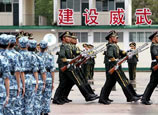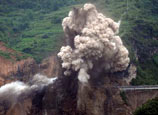
In 2012, apart from building the network mentioned above, Japan has made other significant achievements in this regard.
First, Japan is proactively promoting the so-called “coalition of democracies” by enhancing defense cooperation with the ROK and Australia. The basic line of thought for Japan is to make use of the Japan-U.S. coalition framework to enhance security cooperation with the ROK and Australia. Japan and Australia reached the Acquisition and Cross-Servicing Agreement (ACSA) in 2010; and in 2012, the two countries also signed the General Security of Military Information Agreement (GSOMIA). The ministerial-level defense talks between Japan and Australia in September 2012 laid out guidelines for bilateral defense cooperation centering upon defense equipment and technology. The deepening of security cooperation between Japan and the ROK is also worthy of note. With the conservative Lee Myung-bak in power, and with the tense situation on the Korean Peninsula since 2010, Japan intended to make Japan-ROK defense cooperation the key to its regional security strategy. Beginning in 2010, Japan started negotiations with the ROK on reaching both ACSA and GSOMIA. The two countries all but reached the objective in May 2012, when ROK gave up in the last minute.
Second, Japan is proactively promoting defense cooperation with India. Japanese Prime Minister Yoshihiko Noda visited India in December 2012, and the two countries signed a joint statement entitled “Vision for the Enhancement of Japan-India Strategic and Global Partnership”. In the statement, the two countries agreed to greater maritime security cooperation. In line with the statement, Japan and India conducted their first ever joint maritime exercise in June, 2012.
Third, Japan is seeking to enhance security cooperation and partnership with Southeast-Asian countries such as the Philippines and Vietnam. As friction arose since 2010 between the Philippines and Vietnam and China in the South China Sea, Japan saw opportunities to engage in regional security affairs for greater political influence. When Mr. Noda became Prime Minister in September 2011, Japan has significantly enhanced security cooperation with both the Philippines and Vietnam, and had signed joint statements concerning maritime security cooperation with both countries. Since 2012, Japan has decided to provide both countries with patrol ships and help improve their coast guard capabilities with Official Development Assistance (ODA). Vietnamese Prime Minister Nguyen Tan Dung visited Japan in April, 2012; and in July of the same year Japanese Foreign Minister Koichiro Gemba visited India. In both visits, the two countries highlighted their intention to enhance maritime security cooperation. In addition, three training vehicles of the JMSDF arrived in the Philippines for a five-day goodwill visit in May, 2012, when China and the Philippines were having dispute over the Huangyan Island. In August, 2012, Shikishima (PLH), the largest patrol vessel from Japan Coast Guard participated separately in maritime drills with the Philippines and Vietnam. In January 2013, Mr. Shinzo Abe visited Vietnam, Thailand, and Indonesia, and Foreign Minister Fumio Kishida conducted parallel visits to the Philippines, Singapore, and Brunei. During all these visits, both Mr. Abe and Mr. Kishida emphasized maritime security cooperation.
Apart from multinational exercises, Japan was also actively engaged in regional multilateral security consultations and dialogues in 2012. It tried to increase its influence in regional security affairs by laying out topics, setting agenda, and dominating the discourse. On internal forums such as the ARF, EAS, ADMM+ and ASD (a track-II dialogue), Japan sided with the U.S. and relevant ASEAN members on such issues as maritime security and China’s defense buildup.
【11】 【12】 【13】 【14】 【15】 【16】 【17】


















 Elder couples celebrate golden wedding anniversary in Hangzhou
Elder couples celebrate golden wedding anniversary in Hangzhou


![]()
